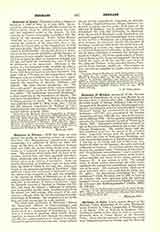

Hermann of Salza, fourth Grand Master of the Teutonic Order, descendant of the noble Thuringian house of Salza; b. 1180 at Langensalza in Thuringia; d. March 19, 1239, at Barletta in Southern Italy. Nothing is known of him until in 1210 he succeeded Hermann Bart as Grand Master of the Teutonic Order. Soon after his accession he became one of the most influential persons in Europe, and the Teutonic Order, which had dwindled down to a mere handful of knights, enjoyed a period of unprecedented prosperity during his term of office. In 1211 King Andrew II of Hungary applied to Hermann for assistance against the pagan Cumanes who had repeatedly devastated the southeastern portion of Transylvania. Hermann sent some of his knights to settle in that district and protect it against further devastation. As reward he received the so-called Burzaland, a territory along the River Burza, including Kronstadt and its vicinity. The Hungarian nobility, however, protested against this grant and the knights were compelled to leave Burzaland in 1225. About this time Duke Conrad of Masovia and Bishop Christian of Prussia agreed to ask the Grand Master for assistance against the pagan Prussians who continually harassed the Christian settlers in and near Prussia. In case the Prussians were subdued by the order, the Duke of Masovia offered Hermann the district of Culm and all the territory which the order could bring under subjection in Prussia. In a diploma of March, 1226, Emperor Frederick II allowed Hermann to accept the offer and gave him all the rights of a sovereign. The Grand Master appointed Hermann von Balk to take charge of the hostile operations against the Prussians, and under his direction began, in 1230, that memorable series of expeditions which finally resulted in the Christianization of Prussia and raised the Teutonic Order to one of the great powers of the Middle Ages. The strength of the order was materially increased when in 1237 it absorbed the Order of the Brothers of the Sword.
Amidst these activities of the Teutonic Order in the north, Hermann never lost sight of the main object of his order, the recovery of the Holy Land. With many of his knights he accompanied the German crusaders to the Holy Land and distinguished himself for his heroism at the taking of Damietta in 1219. In reward for his bravery John of Brienne, the King of Jerusalem, honored him with the Golden Cross of Jerusalem, which he thereafter wore beside the black cross of his order. He incessantly urged Emperor Frederick II to undertake the crusade which he had repeatedly promised to Honorius III, and in order to join the interests of the Holy Land with those of the emperor he influenced him to marry the daughter of John of Brienne, Iolanthe, who was heiress to the throne of Jerusalem. It was chiefly due to the efforts of Hermann that in 1226 a reconciliation was effected between the emperor and the Lombard cities. In 1228-9 he accompanied the excommunicated emperor to Jerusalem, and upon their return to Italy he effected the famous Treaty of San Germano on July 23, 1230, by which the Patrimony of St. Peter was reconstituted and the ban removed from Frederick II. Hermann spent the remaining nine years of his life mostly in Italy, working incessantly for the welfare of the Teutonic Order.
MICHAEL OTT

